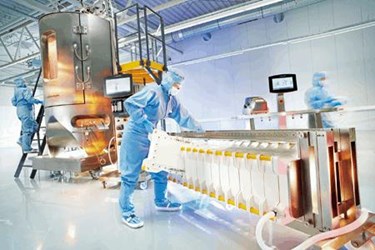Single-Use Platforms Helping Democratize Biomanufacturing

By Miriam Monge and Dr. Nick Hutchinson, Sartorius Stedim Biotech
Single-use technology has been used in bioprocessing for over 20 years. Once a niche technology to replace plastic or glass carboys it has now developed to the extent that it is commonly used throughout the industrial-scale manufacture of biologics (Heaven, 2016). Standardized process platforms comprising of entirely single-use technologies from seed bioreactors through to final bulk product storage are available for monoclonal antibodies and more are in development (Monge, 2016). There are many companies that have limited resources and find it difficult to establish internal manufacturing capacity. Single-use platforms reduce the burden of bioprocess design and provide a cost-effective means of developing in-house capacity.
This article examines key advances in single-use process platforms that are simplifying the implementation of biomanufacturing processes still further and are delivering significant benefits to drug developers by allowing them to decrease the time taken for products to reach the market, increase product safety and decrease manufacturing costs.
 The design of single-use processes during the early stages of biopharmaceutical development can be facilitated by novel development tools. The ambr® 250 modular system is an example of a unique single use scale-down model that is used for rapid process development and optimization. The basic system is a two bioreactor system and can be expanded to 4,6 or 8 bioreactor configuration, where all the bioreactor stations have complete individual process control on all parameters including pH, dissolved oxygen temperature and agitation. The single use bioreactor is fully integrated to sensors, five reagent reservoirs and syringe pumps, this allows for very easy experimental set-up and turnaround. In addition, the bioreactor vessel is geometrically similar to standard bench-top bioreactor enabling the system to be an excellent scale-down model. All this means that the ambr® 250 modular system allows bioprocess engineers to significantly increase productivity while eliminating any need for sterilization of bioreactors or its accessories.
The design of single-use processes during the early stages of biopharmaceutical development can be facilitated by novel development tools. The ambr® 250 modular system is an example of a unique single use scale-down model that is used for rapid process development and optimization. The basic system is a two bioreactor system and can be expanded to 4,6 or 8 bioreactor configuration, where all the bioreactor stations have complete individual process control on all parameters including pH, dissolved oxygen temperature and agitation. The single use bioreactor is fully integrated to sensors, five reagent reservoirs and syringe pumps, this allows for very easy experimental set-up and turnaround. In addition, the bioreactor vessel is geometrically similar to standard bench-top bioreactor enabling the system to be an excellent scale-down model. All this means that the ambr® 250 modular system allows bioprocess engineers to significantly increase productivity while eliminating any need for sterilization of bioreactors or its accessories.
 All single-use cell culture-based processes require growth media. Cell culture media represent a significant proportion of total production platform costs and require considerable expertise to develop. Off-the-shelf growth media are available on the market but these are not tailored to the specific needs of individual cell lines. Furthermore, they can bind manufacturers to a single source of supply that may not grant the biopharmaceutical developer access to proprietary formulations. Media optimization services that combine modern DOE-based experimental designs with automated, high-throughput cell culture technology and field-based application support address these challenges. A recent cell culture media development project showed that by adopting this approach a formulation could be derived that increased peak viable cell density by 2.5-fold and delivered a 4-fold increase in antibody titer. Use of these commercially available media optimization services allow media and feeds to be developed in under six months. This enables biomanufacturers to reach the clinic sooner and develop more productive processes.
All single-use cell culture-based processes require growth media. Cell culture media represent a significant proportion of total production platform costs and require considerable expertise to develop. Off-the-shelf growth media are available on the market but these are not tailored to the specific needs of individual cell lines. Furthermore, they can bind manufacturers to a single source of supply that may not grant the biopharmaceutical developer access to proprietary formulations. Media optimization services that combine modern DOE-based experimental designs with automated, high-throughput cell culture technology and field-based application support address these challenges. A recent cell culture media development project showed that by adopting this approach a formulation could be derived that increased peak viable cell density by 2.5-fold and delivered a 4-fold increase in antibody titer. Use of these commercially available media optimization services allow media and feeds to be developed in under six months. This enables biomanufacturers to reach the clinic sooner and develop more productive processes.
Process development tools and media optimization services are likely, to not only increase product titers, but also increase biomass concentrations within bioreactors. It is increasingly common for wet cell weight biomass concentrations to be in the range of 5-10% (w/v). Clarification technologies must also content with process variability challenges. The traditional approach by which engineers simply over-size equipment to prepare for worst-case scenarios is inefficient and costly. New body feed filtration methods can be implemented into single-use platform processes and used to harvest bioreactors with volumes of up to 2000L. Body feed filtration is an established technology that is used in the beverage and plasma fractionation industries amongst others. The technique is now being applied to the biopharmaceutical industry. Bioreactors with up to 15% wet cell weight can be clarified with this method and the technology has been found to be insensitive to cell viability changes. A porous filter aid such as diatomaceous earth is added to the cell-containing culture within a mixing vessel. Together, the biomass and the filter-aid form a permeable filter cake on the upstream side of a subsequent single-use filtration step. Adding more filter aid increases the permeability of the cake and increases permeate flowrates. The optimum diatomaceous earth concentration for mammalian cell cultures appears to be linearly correlated to the wet cell weight. If the wet cell weight is known then the large-scale requirement for the body feed is easily calculated. The body feed contains Celpure® 300, an ultrapure grade of diatomaceous earth specially designed for biopharmaceutical processes.
The effectiveness of the technique has been demonstrated through a trial in which a 1000L bioreactor with 20-30 million CHO cells per mL and an 8% wet cell weight was harvested. 20 kilograms of diatomaceous earth was required for the run and the process fluid passed through thirteen filter units. A low pH precipitation step was performed after the addition of the filter-aid but prior to the filtration step which then took less than 90 minutes.
Another challenge that biomanufacturers face when implementing single-use processes is demonstrating consistent product quality. Process Analytical Technology (PAT) and data-based optimization techniques are helping to provide better control and are leading to more optimized platforms. Fully integrated ‘plug and play’ monitoring and control loops based on advanced real-time analytics and scalable single-use sensors can be fully incorporated into single-use unit operations across production processes. During upstream processing, for example, automated online measurement and control of glucose levels within bioreactors is possible and can be fully integrated into local bioreactor control systems. This type of technology provides automated feedback control that reduces sampling needs and allows continuously available glucose measurement overnight and during weekends to deliver higher cell culture process consistency. In addition to such monitoring and control loops, single-use platforms can benefit from SCADA systems with integrated DOE and multi-variate data analysis functionality to allow the comparison of batches and scales with one another. This approach allows manufacturers to monitor batches in real-time for quality control and early fault detection purposes.
A final point to consider when implementing single-use process platforms is an appropriate QC testing strategy. Biosafety assays provide evidence that virus and bacterial contaminations have not occurred during production. The characterization of the biological activity of a drug can be performed using binding and functional assessments. Increasingly as these tests become more complex, drug manufacturers are outsourcing analytical testing services to service providers. BioOutsource is one such provider that has created a niche within the industry focusing on the biological evaluation of therapeutic monoclonal antibodies. The company provides a comprehensive range of qualified analytical testing services to support the development of biosimilar products.
This article has shown that new technologies and services continue to emerge that can be integrated into single-use process platforms. These advances shorten development times and lead to more highly optimized processes. Cell culture titers can be improved within single-use bioreactors through the use of media optimization services but this will create challenges during harvesting which must be addressed through methods learned from other industries. PAT tools can be applied to single-use operations giving greater control and process consistency. Those biomanufacturers that may have limited resources for bioprocess design can benefit from these innovations which can be provided already integrated into single-use platforms. This will enable them to compete more effectively against large, well-resourced industry players by increasing their speed to clinic, productivity and product quality while reducing upfront capital expenditures.
References
Heaven, L. (2016) What’s Next For Single-Use Technology In Bioprocessing. BIOPROCESS ONLINE. Available at; http://www.bioprocessonline.com/doc/what-s-next-for-single-use-technology-in-bioprocessing-0001?sectionCode=Freeform1&templateCode=Single&user=20&source=nl:45204 Accessed on 4 April 2016.
Monge, M. (2016) Single-Use Process Platforms Help Biomanufacturers Reduce Costs BIOPROCESS ONLINE. Available at; http://www.bioprocessonline.com/doc/single-use-process-platforms-help-biomanufacturers-reduce-costs-0001 Access on 4 April 2016.
